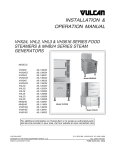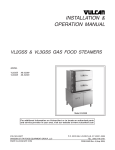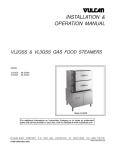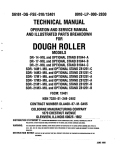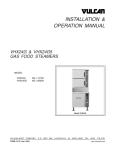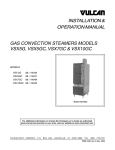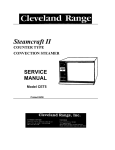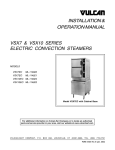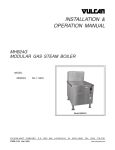Download Vulcan-Hart VHL2G Specifications
Transcript
INSTALLATION & OPERATION MANUAL VHL2G & VHL3G GAS FOOD STEAMERS MODEL VHL2G VHL3G ML-126323 ML-126324 Model VHL2G VULCAN-HART COMPANY, FORM 31179 (Jan. 2001) P.O. BOX 696, LOUISVILLE, KY 40201-0696, TEL. (502) 778-2791 www.vulcanhart.com IMPORTANT FOR YOUR SAFETY THIS MANUAL HAS BEEN PREPARED FOR PERSONNEL QUALIFIED TO INSTALL GAS EQUIPMENT, WHO SHOULD PERFORM THE INITIAL FIELD START-UP AND ADJUSTMENTS OF THE EQUIPMENT COVERED BY THIS MANUAL. POST IN A PROMINENT LOCATION THE INSTRUCTIONS TO BE FOLLOWED IN THE EVENT THE SMELL OF GAS IS DETECTED. THIS INFORMATION CAN BE OBTAINED FROM THE LOCAL GAS SUPPLIER. IMPORTANT IN THE EVENT A GAS ODOR IS DETECTED, SHUT DOWN UNITS AT MAIN SHUTOFF VALVE AND CONTACT THE LOCAL GAS COMPANY OR GAS SUPPLIER FOR SERVICE. FOR YOUR SAFETY DO NOT STORE OR USE GASOLINE OR OTHER FLAMMABLE VAPORS OR LIQUIDS IN THE VICINITY OF THIS OR ANY OTHER APPLIANCE. WARNING: IMPROPER INSTALLATION, ADJUSTMENT, ALTERATION, SERVICE OR MAINTENANCE CAN CAUSE PROPERTY DAMAGE, INJURY OR DEATH. READ THE INSTALLATION, OPERATING AND MAINTENANCE INSTRUCTIONS THOROUGHLY BEFORE INSTALLING OR SERVICING THIS EQUIPMENT. IN THE EVENT OF A POWER FAILURE, DO NOT ATTEMPT TO OPERATE THIS DEVICE. © VULCAN-HART COMPANY, 2001 –2– TABLE OF CONTENTS GENERAL . . . . . . . . . . . . . . . . . . . . . . . . . . . . . . . . . . . . . . . . . . . . . . . . . . . . . . . . . . . . 4 INSTALLATION . . . . . . . . . . . . . . . . . . . . . . . . . . . . . . . . . . . . . . . . . . . . . . . . . . . . . . . Unpacking . . . . . . . . . . . . . . . . . . . . . . . . . . . . . . . . . . . . . . . . . . . . . . . . . . . . . . . Location . . . . . . . . . . . . . . . . . . . . . . . . . . . . . . . . . . . . . . . . . . . . . . . . . . . . . . . . . Installation Codes and Standards . . . . . . . . . . . . . . . . . . . . . . . . . . . . . . . . . . . . Leveling . . . . . . . . . . . . . . . . . . . . . . . . . . . . . . . . . . . . . . . . . . . . . . . . . . . . . . . . . Gas Connection . . . . . . . . . . . . . . . . . . . . . . . . . . . . . . . . . . . . . . . . . . . . . . . . . . . Testing the Gas Supply System . . . . . . . . . . . . . . . . . . . . . . . . . . . . . . . . . . . . . . Flue Connection . . . . . . . . . . . . . . . . . . . . . . . . . . . . . . . . . . . . . . . . . . . . . . . . . . Electrical Connection . . . . . . . . . . . . . . . . . . . . . . . . . . . . . . . . . . . . . . . . . . . . . . Plumbing Connections . . . . . . . . . . . . . . . . . . . . . . . . . . . . . . . . . . . . . . . . . . . . . Water Supply Connections . . . . . . . . . . . . . . . . . . . . . . . . . . . . . . . . . . . . . . . . . . Drain Connection . . . . . . . . . . . . . . . . . . . . . . . . . . . . . . . . . . . . . . . . . . . . . . . . . . Water Quality . . . . . . . . . . . . . . . . . . . . . . . . . . . . . . . . . . . . . . . . . . . . . . . . . . . . . Start-up Test Run . . . . . . . . . . . . . . . . . . . . . . . . . . . . . . . . . . . . . . . . . . . . . . . . . Automatic Blowdown . . . . . . . . . . . . . . . . . . . . . . . . . . . . . . . . . . . . . . . . . . . . . . . 4 4 4 5 5 5 6 6 6 7 7 7 8 8 9 OPERATION . . . . . . . . . . . . . . . . . . . . . . . . . . . . . . . . . . . . . . . . . . . . . . . . . . . . . . . . . Controls — Boiler . . . . . . . . . . . . . . . . . . . . . . . . . . . . . . . . . . . . . . . . . . . . . . . . Boiler . . . . . . . . . . . . . . . . . . . . . . . . . . . . . . . . . . . . . . . . . . . . . . . . . . . . . . . . . . Manual Compartment Controls . . . . . . . . . . . . . . . . . . . . . . . . . . . . . . . . . . . . . . Deluxe Automatic Compartment Controls . . . . . . . . . . . . . . . . . . . . . . . . . . . . . Pre-Vent Steam Mizer Automatic Controls . . . . . . . . . . . . . . . . . . . . . . . . . . . . Selection of Pans for Steam Cooking . . . . . . . . . . . . . . . . . . . . . . . . . . . . . . . . Cleaning . . . . . . . . . . . . . . . . . . . . . . . . . . . . . . . . . . . . . . . . . . . . . . . . . . . . . . . . Cooking Compartment Drains . . . . . . . . . . . . . . . . . . . . . . . . . . . . . . . . . . . . . . Boiler Blowdown . . . . . . . . . . . . . . . . . . . . . . . . . . . . . . . . . . . . . . . . . . . . . . . . . Wash Compartment with Warm Soapy Water . . . . . . . . . . . . . . . . . . . . . . . . . . Door Gaskets . . . . . . . . . . . . . . . . . . . . . . . . . . . . . . . . . . . . . . . . . . . . . . . . . . . . Leave Compartment Doors Open. . . . . . . . . . . . . . . . . . . . . . . . . . . . . . . . . . . . Guidelines for Maintaining Stainless Steel Surfaces . . . . . . . . . . . . . . . . . . . . 10 10 11 12 14 14 15 17 17 17 17 17 17 18 MAINTENANCE . . . . . . . . . . . . . . . . . . . . . . . . . . . . . . . . . . . . . . . . . . . . . . . . . . . . . . Boiler Blowdown . . . . . . . . . . . . . . . . . . . . . . . . . . . . . . . . . . . . . . . . . . . . . . . . . Compartment Pressure Relief Valve . . . . . . . . . . . . . . . . . . . . . . . . . . . . . . . . . Boiler Pressure Relief Valve . . . . . . . . . . . . . . . . . . . . . . . . . . . . . . . . . . . . . . . . Door Gaskets . . . . . . . . . . . . . . . . . . . . . . . . . . . . . . . . . . . . . . . . . . . . . . . . . . . . Air Intake to the Blower . . . . . . . . . . . . . . . . . . . . . . . . . . . . . . . . . . . . . . . . . . . . Scale Related Maintenance . . . . . . . . . . . . . . . . . . . . . . . . . . . . . . . . . . . . . . . . Water Level Gauge . . . . . . . . . . . . . . . . . . . . . . . . . . . . . . . . . . . . . . . . . . . . . . . Lubrication . . . . . . . . . . . . . . . . . . . . . . . . . . . . . . . . . . . . . . . . . . . . . . . . . . . . . . Flue . . . . . . . . . . . . . . . . . . . . . . . . . . . . . . . . . . . . . . . . . . . . . . . . . . . . . . . . . . . Boiler Inspection Plate . . . . . . . . . . . . . . . . . . . . . . . . . . . . . . . . . . . . . . . . . . . . 18 18 18 18 18 18 19 19 19 19 19 TROUBLESHOOTING . . . . . . . . . . . . . . . . . . . . . . . . . . . . . . . . . . . . . . . . . . . . . . . . . 20 Service and Parts Information . . . . . . . . . . . . . . . . . . . . . . . . . . . . . . . . . . . . . . . . . . . 20 –3– Installation, Operation, and Care of MODEL VHL2G & VHL3G GAS FOOD STEAMERS KEEP THIS MANUAL FOR FUTURE USE GENERAL Vulcan-Hart steamers are produced with quality workmanship and material. Proper installation, usage and maintenance of your steamer will result in many years of satisfactory performance. It is suggested that you thoroughly read this entire manual and carefully follow all of the instructions provided. Models VHL2G & VHL3G steamers feature a gas boiler and manual compartment controls. Options include automatic compartment controls and Pre-VentTM automatic compartment controls. The boiler can be built for natural gas or propane with gas input rating of 270,000 BTU/hr. Boiler is rated high efficiency. INSTALLATION Before installing, verify that the electrical service and type of gas supply (natural or propane) agree with the specifications on the rating plate located on the door of the boiler base. If the supply and equipment requirements do not agree, do not proceed with the installation. Contact your dealer or Vulcan-Hart Company immediately. UNPACKING This steamer was inspected before leaving the factory. The transportation company assumes full responsibility for safe delivery upon acceptance of the shipment. Immediately after unpacking, check for possible shipping damage. If the steamer is found to be damaged, save the packaging material and contact the carrier within 15 days of delivery. LOCATION The equipment area must be kept free and clear of combustible substances. The steamer, when installed, must have a minimum clearance from combustible and non-combustible construction of 6" (15.2 cm) at left and right sides and the rear. Provide adequate clearance for servicing and proper operation: Allow 18" (45.7 cm) at left and right sides, 18" (45.7 cm) at the rear, and 36" (91.4 cm) at the front. An exhaust system should be located directly above the steamer to exhaust steam, combustion gases, and heat generated by the steamer. The steamer must be installed so that the flow of combustion and ventilation air will not be obstructed. Make sure there is an adequate supply of air in the room to allow for combustion of the gas at the burner. The floor area beneath the boiler must be kept free and clear. Do not permit fans to blow directly at the steamer and avoid wall-type fans which create air cross currents within the room. Avoid open windows next to the steamer. –4– INSTALLATION CODES AND STANDARDS In the United States, the steamer must be installed in accordance with: 1) State and local codes; 2) National Fuel Gas Code, ANSI-Z223.1 (latest edition), available from American Gas Association, 1515 Wilson Boulevard, Arlington, VA 22209; 3) NFPA-96, Vapor Removal from Cooking Equipment; and 4) National Electrical Code, NFPA-70 (latest edition), available from National Fire Protection Association, Batterymarch Park, Quincy, MA 02269. In Canada, the steamer must be installed in accordance with: 1) Local codes; 2) CAN/CGA-B149.1 Natural Gas Installation Code (latest edition) or CAN/CGA-B149.2 Propane Installation Code (latest edition), available from Canadian Standards Association, 178 Rexdale Boulevard, Etobicoke, Ontario, Canada M9W 1R3; and 3) Canadian Electrical Code, CSA C22.2 No. 3, Electrical Features of Fuel Burning Equipment (latest edition). LEVELING 1. Use a spirit level to adjust the feet to level the steamer left-to-right and front-to-back. 2. Elevate steamer in the front 1⁄16" to 1⁄8" (0.2 cm to 0.3 cm) to give proper drainage. Rotate the adjusting nut on the rear legs clockwise 1 to 11⁄2 turns clockwise. Check drainage by pouring a little water in the compartment; all the water should drain. GAS CONNECTION Gas supply connections and any pipe joint compound must be resistant to the action of propane gases. A 1" (2.5 cm) minimum inside diameter gas supply line is recommended. Connect the gas supply to the gas valve using a 1" to 3⁄4" (1.9 cm) reducer. Make sure the pipes are clean and free of obstructions. Codes require that a gas shutoff valve must be installed in the gas line ahead of the steamer. The burner is equipped with fixed gas and air orifices for use with natural or propane gas. The gas line must be capable of delivering gas to the boiler without excessive pressure drop at the rate specified on the rating plate. The boiler is equipped with a factory preset pressure regulator. No further adjustment should be required. Gas Type Natural Propane Line Pressure Min. Max. Manifold Pressure Pilot Pressure 7" W.C. 14" W.C. 3.0" W.C. 3.5" W.C. (1.75 kPa) (3.5 kPa) (.75 kPa) (.88 kPa) 11" W.C. 14" W.C. 3.0" W.C. 3.5" W.C. (2.7 kPa) (3.5 kPa) (.75 kPa) (.88 kPa) WARNING: PRIOR TO LIGHTING, CHECK ALL JOINTS IN THE GAS SUPPLY LINE FOR LEAKS. USE SOAP AND WATER SOLUTION. DO NOT USE AN OPEN FLAME. After piping has been checked for leaks, all piping receiving gas should be fully purged to remove air. –5– TESTING THE GAS SUPPLY SYSTEM When gas supply pressure exceeds 1⁄2 psig (3.45 kPa), the steamer and its individual shutoff valve must be disconnected from the gas supply piping system. When gas supply pressure is 1⁄2 psig (3.45 kPa) or less, the steamer should be isolated from the gas supply system by closing its individual manual shutoff valve. FLUE CONNECTION DO NOT obstruct the flow of flue gases from the flue located on the rear of the steamer. It is recommended that the flue gases be ventilated to the outside of the building through a ventilation system installed by qualified personnel. A minimum clearance of 18" (45.7 cm) must be maintained from the termination of the flue to the filters of the hood venting system. Information on the construction and installation of ventilating hoods may be obtained from NFPA-96 (latest edition), Vapor Removal from Cooking Equipment, available from National Fire Protection Association, Batterymarch Park, Quincy, MA 02269. ELECTRICAL CONNECTION WARNING: ELECTRICAL AND GROUNDING CONNECTIONS MUST COMPLY WITH THE APPLICABLE PORTIONS OF THE NATIONAL ELECTRICAL CODE AND/OR OTHER LOCAL ELECTRICAL CODES. WARNING: DISCONNECT ELECTRICAL POWER SUPPLY AND PLACE A TAG AT THE DISCONNECT SWITCH TO INDICATE YOU ARE WORKING ON THE CIRCUIT. ELECTRICAL DATA Model Volts / Hertz / Phase Machine Amps Minimum Circuit Ampacity Maximum Protective Device AMPS VHL2G VHL3G 120 / 60 / 1 3.0 15 Compiled in accordance with the National Electrical Code, NFPA-70 (latest edition). Connect the electrical supply circuit to the terminal block located in the boiler control box. A 7/8" diameter hole for 1/2" trade size conduit is provided on the side of the control box. Use copper wire suitable for at least 75°C. A grounding wire must be connected to the ground lug. If a cord and plug is to be used, provide suitable durable cord, molded plug, and a proper strain relief. The wiring diagram is located on the door of the boiler. Do not connect the steamer to electrical supply until after gas connections have been made. –6– PLUMBING CONNECTIONS WARNING: PLUMBING CONNECTIONS MUST COMPLY WITH APPLICABLE SANITARY, SAFETY, AND PLUMBING CODES. Water Supply Connections Two cold water supplies are recommended. Treated water may be required to fill the boiler; untreated water may be used for the cold water condenser on the boiler blowdown line. • Connect cold water supply to the 1⁄2" NPT (1.27 cm) fill water connection. Water treatment may be needed — refer to Water Quality, page 8. Water pressure of 20 – 80 psig is required. • Connect cold water supply to the 1⁄8" NPT (0.3175 cm) cold water condenser connection (treatment is not needed). Water pressure of 20 – 80 psig is required. Drain Connection The 11/4" NPT (3.175 cm) threaded fitting on the condenser box must be extended to an open, air gap type drain, with maximum length of 12 inches (30.5 cm) to the open drain. Do not reduce the 11/4" (3.175 cm) drain piping throughout its length. Provide a suitable floor sink with a minimum depth of 12 inches (30.5 cm). The floor sink is NOT to be directly under the steamer and should be at a distance so that steam vapors will not enter the steamer from underneath. Drain pipe should be either iron or copper. DO NOT use PVC pipe — PVC pipe may lose its rigidity or glue may fail. CAUTION: In order to avoid any back pressure in the steamer, do not connect solidly to any drain connection. –7– WATER QUALITY Before connecting the steamer to water, the water supply should be analyzed to make sure specifications are met. WATER QUALITY SPECIFICATIONS Total Dissolved Solids (TDS)* Total Alkalinity Silica Chloride pH *17.1 ppm = 1 grain of hardness Less than Less than Less than Less than 7.0 to 8.0 60 20 13 30 ppm ppm ppm ppm If the water supply fails to meet these specifications, it will be necessary to install a water conditioner on the boiler cold water supply line. APPLIANCE FAILURE CAUSED BY INADEQUATE WATER QUALITY IS NOT COVERED UNDER WARRANTY. Water supplies vary from one location to another. A local water treatment specialist should be consulted before installing any boiler equipment. Untreated water contains scale producing minerals which can precipitate onto the surfaces in the boiler. Due to the temperatures in the boiler, the minerals can bake onto the surfaces and components. This can result in early component failure and reduced product life. Mineral scale on components causes several problems: 1. The surface of the boiler becomes coated with scale, reducing the heat transfer efficiency. This can produce hot spots on the boiler and result in premature failure. 2. The water level probes become coated with scale. Scale will bridge across the probe insulator from the metal extension which senses the water level in the boiler. Once this scale becomes wet, the water level control is unable to maintain the proper water level in the boiler. This situation may cause the boiler to fail if the boiler is not adequately covered by water. Strainers or filters will NOT remove minerals from the water. Sensors in the boiler use ions in the water to detect the water level. Do not use distilled (fully demineralized or de-ionized) water. This could provide a false reading. START-UP TEST RUN Refer to the OPERATION section, pages 10 – 14 for more information. WARNING: THE STEAMER AND ITS PARTS ARE HOT. CLEANING, OR SERVICING THE STEAMER. USE CARE WHEN OPERATING, After the steamer is installed and proper service connections have been made, thoroughly test the steamer before operation. 1. Turn knob of gas valve counterclockwise to on. 2. Be sure the water inlet valve is open. Close only for service or long shutdown. 3. Locate the power switch and press [ I ] to start. Two indicator lights (Low Water and High Pressure) become lit as water fills the boiler. After about 4 – 5 minutes, the water will reach the required level in the boiler and the green indicator light on the reset switch is lit. –8– 4. Observe water level gauge sight glass to verify required water level. • Keep both valves on the water gauge open at all times. 5. Press the reset switch with the green indicator light lit to light the boiler. 6. Both Low Water and High Pressure indicator lights must be off before the burner will ignite. • If the indicator lights do not go off after 15 minutes or if they come on during normal operation, press [ 0 ] on the power switch for off and contact an authorized Vulcan-Hart servicer. 7. If the burner does not ignite after 30 seconds, press [ 0 ] on the power switch for off, wait 5 minutes, then repeat steps 1 – 5. • If the ignition does not occur after 3 tries, press [ 0 ] on the power switch for off and contact an authorized Vulcan-Hart servicer. 8. Steam generation will begin in about 10 minutes. • Observe that the boiler pressure gauge indicates steam pressure in the range of 8 –12 psig. 9. Set all timer dials to 0 minutes. COMPARTMENT OPERATION 10. Open all compartment doors and observe that no steam has entered the cooking compartments. 11. Close compartment doors. Refer to page 12 for MANUAL CONTROLS. Refer to page 13 for AUTOMATIC CONTROLS. Refer to page 14 for PRE-VENT AUTOMATIC CONTROLS. 12. Set all timer dials to 2 minutes. • Steam will be heard entering the compartments. 13. Wait until 1 minute is left on the timers. 14. Open each door and observe that steam has stopped entering into each compartment. 15. Close compartment doors. • Steam generation and timers resume. • Make sure that steam from the drain is being cooled by water from the cold water condenser. 16. When timer dials are at 0 minutes, steam flow to the compartments stops. 17. Silence the buzzers. 18. Press [ 0 ] on the power switch on the boiler (Fig. 1) to turn the steamer off. • Boiler will automatically blow down. AUTOMATIC BLOWDOWN When [ 0 ] on the power switch on the boiler (Fig. 1) is pressed, the boiler will blow down for approximately 5 minutes. –9– OPERATION WARNING: THE STEAMER AND ITS PARTS ARE HOT. CLEANING, OR SERVICING THE STEAMER. USE CARE WHEN OPERATING, CONTROLS — BOILER (Figs. 1, 2) Power Switch POWER SWITCH HIGH PRESSURE LIGHT • Press [ I ] to begin filling the boiler. • Press [ 0 ] to turn the steamer off (automatic blow down will occur). LOW WATER LIGHT High Pressure Light RESET SWITCH (GREEN) • Is lit after [ I ] is pressed and stays on during fill. Goes off after reset switch is pressed (when green light is lit). • Is lit if pressure exceeds 15 psig. WATER LEVEL GAUGE Low Water Light • Is lit after [ I ] is pressed and stays on until reset switch is pressed (when green light is lit). • Is lit if water level is too low. Reset Switch BOILER PRESSURE GAUGE • Press the reset switch (when green light is lit) to ignite the burner after water has reached the required level. Boiler Pressure Gauge • Indicates the boiler steam pressure; the normal operating range is 8 – 12 psig. PL-41513-1 Fig. 1 Water Level Gauge • The correct water level is one inch of water in the water level gauge sight glass. • The manual valves at the top and bottom of the water level gauge (Fig. 2) must be fully open (counterclockwise). • Observe that the water is clean and clear in the glass tube. - The appearance of extreme murkiness in the water indicates inadequate water quality and will cause the controls and the steamer to fail. Warranty does not cover malfunction due to poor water conditions. – 10 – BOILER (Fig. 2) PRESSURE RELIEF VALVE GAS VALVE PROBE HOUSING BLOWDOWN VALVE WATER INLET VALVE MANUAL VALVES WATER LEVEL GAUGE Fig. 2 PL-41514-1 Pressure Relief Valve • The pressure relief valve located on the top left side prevents pressure in the boiler from exceeding 15 psig. • Manually pull up the lever daily to reduce scale buildup and verify that the pressure relief valve functions properly. Gas Valve • Located behind the door. Turn counterclockwise to on; clockwise to off. Probe Housing Blowdown Valve • Open periodically (monthly) to blow down the probes and remove sediment and scale buildup. • Located toward the back left side, wait until the boiler is cool before opening valve. Water Inlet Valve • Located toward the bottom center in the boiler, turn the valve off to shut off the water supply. – 11 – MANUAL COMPARTMENT CONTROLS (Fig. 3) STEAM CONTROL HANDLE Door Latch • DOOR LATCH Holds door closed. Door Screw Handle (not shown) • Seals door gasket against cabinet. Steam Control Handle • Pull out and down to open steam valve. • Push up and back to turn steam valve off. Cooking Time Control COOKING TIME CONTROL PL-41519-1 Fig. 3 • Sets the desired cooking time (0 – 60 minutes). • At end of cooking cycle, buzzer sounds for a short interval and then stops. Refer to Steam Cooking with Vulcan Kettles and Steamers (packed with your steamer) for suggested cooking times. Size, weight, pan loading and product quality will affect cooking times and should be adjusted to your own requirements. 1. Prepare vegetables, fruits, meats, seafood and poultry as you would for steam cooking or cooking in water (clean, separate, cut, remove stems, etc). Place in pan. 2. Place loaded pans in the compartment and close the compartment door. Turn the door screw handle clockwise to seal the door gasket. Normal pressure will seal the compartment. However, a new gasket may require additional pressure after it becomes heated. After the pressure gauge located under the lower compartment controls reaches a maximum pressure of 5 to 6 psig, turn the door screw handle clockwise enough to stop the leakage. The pressure gauge indicates steam pressure in the steam supply pipe, not the compartment. 3. The timer knob must be turned to 10 minutes or beyond to trip the switches. The knob may then be turned back to a lower setting if a shorter set time is desired. When setting the timer, add to the cooking time 3 to 12 minutes for preheat. The timer setting depends on the type, size, temperature, and condition (frozen or thawed) of the load and must be determined from experience. 4. Pull the steam control handle forward and lock it by pulling the arm down. The door latch cannot be opened when the steam control handle is pulled forward. This closes the drain and allows steam to enter the compartment. Air is automatically vented from the compartment as steam enters. The escaping air causes a hissing sound audible during the early part of the cycle. 5. When the timer buzzes (5 to 10 seconds), lift the arm and give it a slight push to the rear. An internal spring will automatically pull the arm to the rear, shutting off the steam supply and opening the drain. 6. Wait a minimum of 1 minute for the steam and condensation in the compartment to exhaust. Then loosen the screw handle on the compartment door, allowing moisture to escape. After a few seconds, move the latch to the left. Then open the door and remove pans of food. – 12 – AUTOMATIC COMPARTMENT CONTROLS (Fig. 4) Optional Door Latch STEAM CONTROL HANDLE • Holds door closed. Door Screw Handle (not shown) • Seals door gasket against cabinet. DOOR LATCH Steam Control Handle • Pull out and down to open steam valve. • Push up and back to turn steam valve off. Cooking Time Control • Sets the desired cooking time (0 – 60 minutes). Compartment Switch COOKING TIME CONTROL COMPARTMENT SWITCH PL-41445-1 Fig. 4 • Press top of switch to start the timer. • At end of cooking cycle, press bottom of switch to silence buzzer. Refer to Steam Cooking with Vulcan Kettles and Steamers (packed with your steamer) for suggested cooking times. Size, weight, pan loading and product quality will affect cooking times and should be adjusted to your own requirements. 1. Prepare vegetables, fruits, meats, seafood and poultry as you would for steam cooking or cooking in water (clean, separate, cut, remove stems, etc). Place in pan. 2. Place loaded pans in the compartment and close the compartment door. Turn the door screw handle clockwise to seal the door gasket. Normal pressure will seal the compartment. However, a new gasket may require additional pressure after it becomes heated. After the pressure gauge located under the lower compartment controls reaches a maximum pressure of 5 to 6 psig, turn the door screw handle clockwise enough to stop the leakage. The pressure gauge indicates steam pressure in the steam supply pipe, not the compartment. 3. The timer knob must be turned to 10 minutes or beyond to trip the switches. The knob may then be turned back to a lower setting if a shorter set time is desired. When setting the timer, add to the cooking time 3 to 12 minutes for preheat. The timer setting depends on the type, size, temperature, and condition (frozen or thawed) of the load and must be determined from experience. 4. Pull the steam control handle forward and lock it by pulling the arm down. The door latch cannot be opened when the steam control handle is pulled forward. This closes the drain and allows steam to enter the compartment. Air is automatically vented from the compartment as steam enters. The escaping air causes a hissing sound audible during the early part of the cycle. Press the top half of the red switch located under the timer. This starts the timer. 5. When the timer reaches 0 minutes, the arm automatically moves to the rear, shutting off the steam supply and opening the drain. The compartment will exhaust for about one minute, then the continuous buzzer will sound, indicating the end of the cooking cycle. 6. Turn the steamer off by pressing the bottom half of the switch. Then loosen the door screw handle, allowing moisture to escape. After a few seconds, move the door latch to the left. Then open the door and remove pans of food. – 13 – PRE-VENTTM AUTOMATIC COMPARTMENT CONTROLS (Fig. 5) Optional TEMPERATURE SENSOR DOOR LATCH STEAM CONTROL HANDLE COOKING TIME CONTROL COMPARTMENT SWITCH Fig. 5 PL-41520-1 Door Latch • Holds door closed. Door Screw Handle (not shown) • Seals door gasket against cabinet. Steam Control Handle • Pull out and down to open steam valve. • Push up and back to turn steam valve off. Cooking Time Control • Sets the desired cooking time (0 – 60 minutes). Compartment Switch • Press top of switch to start the timer. • At end of cooking cycle, press bottom of switch to silence buzzer. Temperature Sensor • Starts timer when cooking compartment temperature reaches 175 – 185°F. Refer to Steam Cooking with Vulcan Kettles and Steamers (packed with your steamer) for suggested cooking times. Size, weight, pan loading and product quality will affect cooking times and should be adjusted to your own requirements. 1. Prepare vegetables, fruits, meats, seafood and poultry as you would for steam cooking or cooking in water (clean, separate, cut, remove stems, etc). Place in pan. 2. Place loaded pans in the compartment and close the compartment door. Turn the door screw handle clockwise to seal the door gasket. Normal pressure will seal the compartment. However, a new gasket may require additional pressure after it becomes heated. After the pressure gauge located under the lower compartment controls reaches a maximum pressure of 5 to 6 psig, turn the door screw handle clockwise enough to stop the leakage. The pressure gauge indicates steam pressure in the steam supply pipe, not the compartment. 3. The timer knob must be turned to 10 minutes or beyond to trip the switches. The knob may then be turned back to a lower setting if a shorter set time is desired. 4. Pull the steam control handle forward and lock it by pulling the arm down. The door latch cannot be opened when the steam control handle is pulled forward. Air is automatically vented from the compartment as steam enters. The escaping air causes a hissing sound audible during the early part of the cycle. 5. Set the timer to the desired cooking time. 6. Press the top half of the red switch located under the timer to start the timer. The red light will not light and the timer will not start until the interior compartment temperature reaches 175 – 185°F (79 – 85°C). During this automatic pre-vent / defrost period, the drain is open, freely venting any air and condensate. At 175°F, the drain closes, the timer starts, and the red light comes on. During the cooking cycle, the compartment will reach 5 to 6 psig. Also, limited venting takes place through the compartment drain during cooking removing condensate and residual air. 7. When the timer reaches 0 minutes, the arm automatically moves to the rear, shutting off the steam supply and opening the drain. The compartment will exhaust for about one minute, then the continuous buzzer will sound, indicating the end of the cooking cycle. 6. Turn the steamer off by pressing the bottom half of the red switch. Then loosen the door screw handle, allowing moisture to escape. After a few seconds, move the door latch to the left. Then open the door and remove pans of food. – 14 – SELECTION OF PANS FOR STEAM COOKING Vulcan Apapt-A-PanTM steamer compartments are designed to accept combinations of the following perforated or solid cooking pans (Fig. 6). Maximum Quantity Depth of Pan (4) 12" x 20" (30 cm x 51 cm) 6" (15 cm) (6) 12" x 20" (30 cm x 51 cm) 4" (10 cm) (8) 12" x 20" (30 cm x 51 cm) 2 1/ 2" (6 cm) (6) 18" x 26" (46 cm x 66 cm) (After removal of center support) 1" (2.5 cm) 12 x 20 x 6" PAN 12 x 20 x 4" PAN 12 x 20 x 21/ 2 " PAN 18 x 26" SHEET PAN ACCESSORY PULL-OUT SHELF PL-41515-1 Fig. 6 – 15 – The following chart lists the type of pan to use for various foods: FRESH PRODUCT TYPE PAN Solid 12" x 20" (30 x 51 cm) Perforated 12" x 20" (30 x 51 cm) 18" x 26" (46 x 66 cm) PRODUCT EXAMPLES Dehydrated Fruits and Vegetables Dried peaches, prunes, apples, and apricots. Sliced onions and sliced potatoes. Cereals and Puddings Cream of wheat, rolled oats, rice. Vegetables—to be cooked in their own liquid Broccoli, brussel sprouts, peas, cauliflower Meats and Poultry To save broth, cook in solid pans. Canned Foods Place opened can in solid pan or pour contents into the pan. Root Vegetables* Potatoes, carrots, beets, turnips, onions, parsnips, rutabagas, oyster plant. Sausages Frankfurters, weiners, garlic sausages, meat sausages. Leaf Vegetables* Spinach, kale, turnip greens, collard greens, cabbage. Miscellaneous Corn on the cob, green beans, celery and celery hearts, green pepper shells, squash, mushrooms. Eggs in their shells. Precooked and partially Cooked Sliced Meats Ham, meat loaf, roast beef, chicken, turkey, hamburger patties. *If you wish to save liquids from root or leaf vegetables, place them in a solid pan, or place a solid pan under the perforated pan. FROZEN PRODUCT Perforated Frozen Vegetables. Broccoli, asparagus spears, green beans, carrots, Loosen and spread vegetable. brussel sprouts, turnips, potatoes, cut corn, lima beans, peas, squash. Solid Precooked Dishes. Remove wrapping and place in pan. All precooked dishes, such as beef goulash, chicken fricasse, etc., which cannot be cooked in the containers in which they are packed. Separate frozen food packs into smaller chunks. If unpacked precooked frozen dishes require more than 15 minutes to cook, cover the pan. When a cover is used, about one-third more cooking time is required. This is true for foods in portion size or larger which cannot be cooked in the covered containers in which they are packed. Cooking time required for frozen foods depends upon the amount of defrosting required. If time permits, allow the frozen foods to partially thaw overnight in a refrigerator. This will reduce their cooking times. – 16 – CLEANING Cooking Compartment Drains Keep compartment drains running freely. Inspect compartment drains daily for blockage. Remove any particles or debris from the perforated strainer daily or more often if needed. After cooking greasy foods, close the doors and operate each compartment for 15 – 30 minutes to flush any residual grease and oils down the compartment drain. Pour one-half gallon (2 liter) of warm soapy water down the drain and rinse with one-half gallon (2 liter) of hot clear water. Boiler Blowdown To prevent malfunction of controls and clogging, it is essential to flush (blow down) the boiler every day. This will flush out any accumulated minerals (left from the feed water) and aid in preventing internal scale build-up which, in time, would interfere with proper boiler operation. Failure to blow down the boiler every day may void the warranty applying to the controls. The presence of minerals in suspension is indicated by a murky or milky condition in the first portion of the water drained. WARNING: THE WATER BEING DRAINED IS HOT AND UNDER PRESSURE. USE CARE WHEN CLEANING OR SERVICING THE BOILER. After the steamer boiler has been in operation, press [ 0 ] to blow down the boiler removing sediment, scale, or lime build-up in the boiler. The boiler will blow down for approximately 5 minutes. WARNING: DISCONNECT ELECTRICAL POWER BEFORE CLEANING Wash Compartment with Warm Soapy Water Wash the inside of the compartment using warm soapy water and rinse with warm clear water. Once a week thoroughly clean the exposed surfaces (sides, front, door, top) with a damp cloth and polish with a soft dry cloth. To remove discolorations, use a non-abrasive cleaner. Door Gaskets Clean gasket sealing surface of compartment doors to remove harmful food acids for maximum gasket life. Do not use any solvents. Wash with a cloth moistened in a solution of mild detergent and warm water. Rinse with a fresh cloth moistened with warm clear water to remove all traces of detergent. Wipe dry with a soft clean cloth. Never apply food oils or petroleum lubricants directly to the door gasket. Petroleum based solvents and lubricants will shorten door gasket life. Leave Compartment Doors Open CAUTION: Leave the compartment doors slightly open when the steamer is not in use. When the compartment is idle, never latch the door and apply pressure to the door gasket. Leaving the gasket under pressure can cause permanent deformation which will greatly shorten the gasket life. – 17 – GUIDELINES FOR MAINTAINING STAINLESS STEEL SURFACES There are three things that can breakdown stainless steel and allow corrosion to develop: 1) Abrasion; 2) Deposits and water; and 3) Chlorides. Avoid rubbing with steel pads, wire brushes, or scrapers that can leave iron deposits on stainless steel; instead, use plastic scouring pads or soft cloths. For stubborn stains, use products such as Cameo, Talc, or Zud First Impression. Always rub parallel to the polish lines or with the grain. Hard water can leave deposits that promote rust on stainless steel. Treated water from softeners or certain filters can eliminate these mineral deposits. Other deposits from food or lubrication must be properly removed by cleaning. Use mild detergent and non-chloride cleaners. Rinse thoroughly. Wipe dry. If using chloride containing cleaners or sanitizers, rinse repeatedly to avoid stainless steel corrosion. Where appropriate, apply a polish recommended for stainless steel (such as Benefit or Super Sheen) for extra protection and lustre. MAINTENANCE WARNING: THE STEAMER AND ITS PARTS ARE HOT. USE CARE WHEN OPERATING, CLEANING OR SERVICING THE STEAMER. WARNING: DISCONNECT ELECTRICAL POWER SUPPLY BEFORE SERVICING THE STEAMER. BOILER BLOWDOWN At least once daily after the steamer boiler has been in operation, press [ 0 ] to blow down the boiler in order to remove sediments, scalants, and lime build-up in the boiler. COMPARTMENT PRESSURE RELIEF VALVE At least once every day, check the pressure relief valve (set to open at 8 psi) to see that it is functioning properly. The valve is located in the steam supply plumbing. Trip the pressure relief valve when the steam gauge shows 4 psi or above. When steam escapes, release the valve. BOILER PRESSURE RELIEF VALVE At least once every day, check the pressure relief valve (set to open at 15 psi) to see that it is functioning properly. The valve is located on the top left side of the boiler. Trip the pressure relief valve when the steam gauge shows 4 psi or above. When steam escapes, release the valve. DOOR GASKETS After compartments with new door gaskets have been in service for a few days, tighten the door gasket retainer screws. If the door gasket is nicked or cut, it must be replaced. Damage to the gasket sealing surface will cause steam leakage. AIR INTAKE TO THE BLOWER The air intake to the blower needs to be periodically (once a month) cleaned or wiped. – 18 – SCALE RELATED MAINTENANCE Periodic maintenance is necessary to keep your boiler clean and efficient. It is recommended that initially after three months of steamer usage you have your Vulcan Hart authorized servicer inspect the boiler and perform the below listed maintenance and inspections. Local water conditions and steamer usage will determine the frequency that this service must be repeated; however, a minimum recommendation is once a year. This maintenance is not covered by warranty. • Descaler — Automatic descalers are provided inside the boiler to hold minerals in a suspended state so they can be flushed out. This descaler will be consumed. The rate of consumption depends upon the chemical makeup of the feed water and the average volume of feed water required. An inspection by service personnel is recommended until it is learned from experience what the normal life of the descalers are under your operating conditions. • Boiler Scale — Have the servicer inspect the boiler through the hand hole for lime build-up. Have your servicer open the washout plug under the boiler and add water to flush out any loose scale. If a build-up of scale is present that indicates the boiler should be delimed, have the servicer delime the boiler at this time. If a water treatment system that has its own delime procedure is being used, follow the procedures provided with the water treatment system. • Boiler Drain Valve Strainer — Have your servicer clean the strainer screen as needed. • Water Level Probes — Have your servicer inspect and clean the water level probes in the boiler. WATER LEVEL GAUGE Check sight glass assembly daily. The correct water level is approximately one inch of water in the gauge glass. Extremely murky water in the sight glass indicates bad water conditions. The boiler should be blown down. If conditions persist, have the boiler cleaned by your Vulcan-Hart authorized servicer. LUBRICATION The door screw was factory lubricated with high-temperature grease, but will require periodic lubrication. When the door screw is properly lubricated, the hand pressure required to seal the door is greatly reduced and the life of the screw and nut are lengthened. The frequency of lubrication should depend upon use. Lubricate monthly at first and let experience determine the frequency. A hightemperature door screw grease can be obtained from Vulcan-Hart Company. FLUE When cool, annually check the flue to be sure it is free of obstructions. BOILER INSPECTION PLATE The plate must be removed for boiler inspection every 12 months according to state code. This must be done by a boiler inspector. – 19 – TROUBLESHOOTING PROBLEM POSSIBLE CAUSE POSSIBLE REMEDY Boiler will not fill. Boiler's power and water supply are off. Check that power and water supply are on. Boiler will not heat or build pressure. Gas supply is off. Check that gas supply is on. Refer to Start-Up Test Run, pages 8 – 9. SERVICE AND PARTS INFORMATION To obtain service and parts information concerning this steamer, contact the Vulcan-Hart Service Agency in your area (refer to listing supplied with the steamer), or Vulcan-Hart Company Service Department at the address or phone number shown on the front cover of this manual. FORM 31179 (Jan. 2001) – 20 – PRINTED IN U.S.A.





















